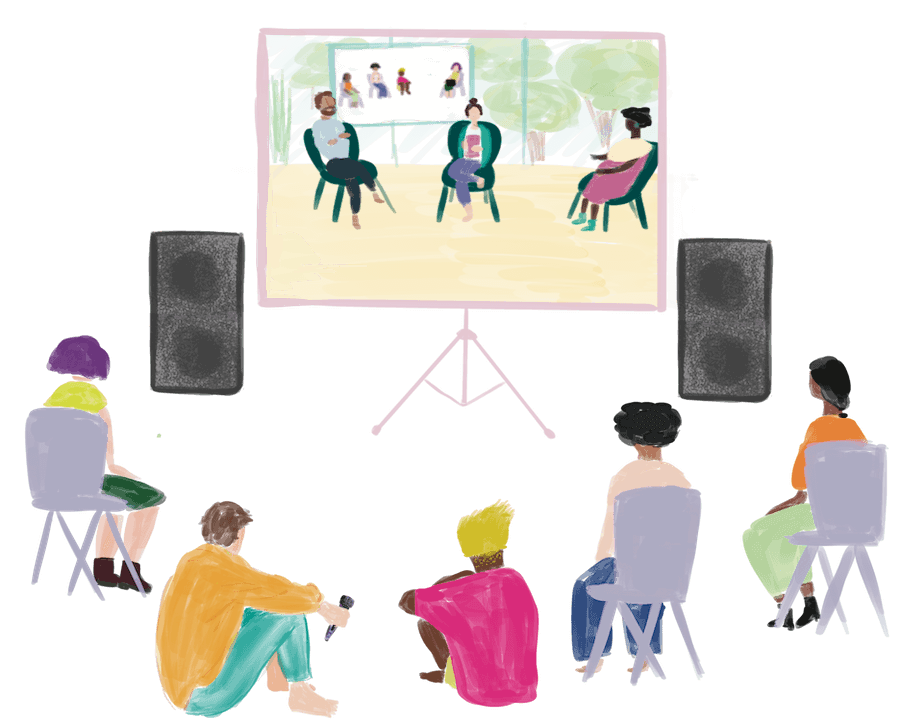
While our post-pandemic lives have exposed us to new and creative ways to connect, we have also stumbled upon challenges for making participation more inclusive in practice as well as in principle. This is an important consideration whether we are gathering on-site, online or both – what is known as a hybrid event.
With over 30 years experience in remote work, APC has amassed extensive learnings on effective and strategic ways to plan for events with hybrid modalities, and have published these in the Hybrid events guide 101. This collection was crafted to complement the resources presented in APC’s Closer than ever guide for social change organisations who want to work online.
“Learning about hybrid gatherings is like practicing belonging in our flesh-and-bone bodies and our data bodies, and breaking the binary code between the two,” explains hvale vale, part of the APC Closer Than Ever (CTE) Team that developed the guide. “We wanted to help people understand that technology is part of facilitation, it's woven into the way you think and understand, and we need to organically think of them together.”
Why organise a hybrid gathering?
Reflecting back on the pandemic, we can see how our abilities to connect have deepened and evolved. However, these have not been without serious challenges. Some people have reached points of “digital burnout” where the added time spent online has caused screen fatigue and alienation. Others have felt relief at not having to travel for meetings, conferences and workshops, preferring the comfort of their home office and avoiding disruption to their daily lives.
Today, even as we have more opportunities to come together in person, we have learned some important lessons throughout the pandemic that have made us question the necessity of travel for events and meetings. By participating remotely, we can reduce costs and logistical planning, lower carbon emissions and environmental impact, and mitigate fatigue and potential health risks.
At the same time, humans will always need spaces to come together in person. A face-to-face gathering creates a special dynamic that can be difficult to replicate through screens.
This is why we have witnessed a significant surge in the need and demand for hybrid meetings in recent years, which allow people the choice of participating either on-site or online, facilitated by technology. However, ensuring that a hybrid event runs smoothly and offers people equal opportunities for engagement comes with a special set of considerations.
“A hybrid event has elements of both on-site events and online events by design, forcing you to rethink the space as a combination of both worlds,” the guide explains, outlining why it is crucial to consider best practices for nurturing a single shared space when planning an event with both remote and in-person options.
Learning how to create inclusive spaces
The hybrid events guide contains a wealth of information to help organisers think strategically about what is required to effectively plan and run a hybrid event, and create a space that is inclusive and welcoming for all who engage regardless of modality.
A hybrid event starts long before participants enter the meeting room or connect to the call. “This new format requires a double effort to plan, run and support the event in such a way that all participants feel part of the event and not disconnected,” the guide points out, offering practical tips and checklists to ensure that a hybrid gathering is fully inclusive and participatory for people who are joining both online and in-person. For example, did you know you need to design the content, goals and timing of an event for the slower of the two spaces? (Hint: it’s the online one).
In addition, the guide offers a hands-on list for preparing a functional tech kit, which is a critical component for planning ahead to ensure things run as smoothly as possible. It suggests a minimum, a desirable and an ideal setup for hybrid events, as well as detailed tech support tips for online, in-person and hybrid meetings.
“Remember that a hybrid event is not just broadcasting a conference: it is making sure participants who are remote are given as many opportunities for interaction as the ones on-site,” the guide cautions. “This means that a successful hybrid event requires a lot of planning beforehand, and several people to work together to run it seamlessly.”
The pleasure and possibilities of hybrid events
APC has tried to take some of the guesswork out of hybrid event preparation by collecting learnings and experiences from across teams and compiling them in the hybrid event guide. It offers practical and thoughtful considerations for planning an event, whether remotely, physically together, or a combination of both.
Each event will have its own special dynamics and there are many options to consider, but the opportunity to make time spent together more meaningful is an exciting and worthwhile prospect. As noted in the final words of the guide: “Hybrid events can offer the best of both worlds: the pleasure of being together after the pandemic, and the possibilities of connecting people online.”
Be sure to also see APC guidelines on planning and designing online events as well as the Closer than ever (CTE) section in apc.org for more information on navigating our post-pandemic world together.
